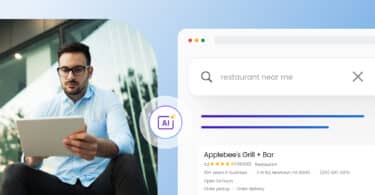Imagine potential customers searching for a great dining spot, only to find your restaurant buried on the second page of Google results. This oversight can lead to lost opportunities, reduced foot traffic, and decreased revenue – all direct consequences of a poorly executed restaurant SEO (search engine optimization) strategy. Local restaurant searches consistently dominate Google, and being visible at the right place and time can supercharge growth.
However, SEO for your restaurant business differs from that of other service businesses. It requires a nuanced understanding of diner behavior, search intent, and other key factors.
This detailed blog post will provide actionable restaurant SEO tips to help you climb search rankings, attract more diners, and turn online searches into real-world customers.
Table of contents
- What is restaurant SEO?
- Importance of restaurant SEO
- Key challenges in restaurant SEO: Why do businesses struggle?
- 12 restaurant SEO strategies to drastically improve your footfall
- 1. Optimize your Google Business Profile
- 2. List your restaurant on popular restaurant directories and marketplaces
- 3. Identify the top keywords for your restaurant
- 4. Build an engaging website
- 5. Optimize for website for mobile visitors
- 6. Focus on the technical side of your restaurant’s website
- 7. Create location-specific content for your website
- 8. Build a strong presence on social media
- 9. Generate and manage customer reviews effectively
- 10. Improve the online ordering system
- 11. Enable online table booking and confirmations
- 12. Use AI chatbots to improve diner experience
- A quick SEO checklist for restaurants
- Frequently asked questions on restaurant SEO
- Restaurant SEO – your path to digital dining dominance
- Supercharge your restaurant’s SEO efforts with Birdeye’s GenAI tools
What is restaurant SEO?
Restaurant SEO is a digital marketing strategy that will improve a restaurant’s visibility in search engine results, helping potential diners find the establishment more easily online.
Related read: 10+ digital marketing strategies for restaurants
Importance of restaurant SEO
Birdeye’s study shows that restaurants were among the top three local business searches in the past year, with 73% of respondents revealing that they looked for local restaurants. This statistic alone underscores the importance of ranking higher on Google.
However, focusing on restaurant SEO strategies also helps your business:
Increase traffic coming to your website
Diners like to explore the restaurant before walking through the doors, so restaurants that rank higher on Google see an uptick in web traffic from curious diners.
Increase online orders and reservations
Convenience is the name of the game, especially in the restaurant industry. If potential diners can’t find your reservation link or website, they will likely skip to the next best restaurant. Optimizing the Google Business Profile and restaurant website SEO for local keywords can improve visibility and increase the volume of online orders/reservations.
Build brand awareness
The goal is not to convert diners at every Google search. However, consistently appearing at the top of local rankings boosts brand recall and awareness, eventually leading to a higher lead conversion rate.
Key challenges in restaurant SEO: Why do businesses struggle?
Investing in SEO brings many advantages to the table for restaurants, but effective implementation can be a challenge. Large-scale restaurant businesses, in particular, struggle to maintain consistency, identify key platforms, and build profiles that outshine their competitors.
Let us explore these challenges in detail.
Multiple listing variations across platforms
Modern restaurants must maintain their presence across multiple review platforms. Each platform has different requirements, features, and best practices. Managing a unified presence across all these platforms requires systematic approaches and consistent attention.
There is also the additional challenge of understanding which platforms are essential for your business to rank higher on searches. Often, businesses chase ineffectual platforms that may not really have a huge impact on their search engine rankings.
Mismatched NAP (Name, Address, Phone) details
Restaurants often have different business listings across various platforms. This creates confusion when your establishment appears under slightly different names, descriptions, or categories. Search engines see these variations as separate businesses, which dilutes your SEO strength and reduces visibility in search results.
Consistency in NAP details is crucial for local SEO success. Search engines struggle to verify your business information when these details vary across platforms. This inconsistency directly impacts your local search rankings and makes it harder for customers to find accurate information about your restaurant.
Potential for customer confusion and lost trust
Outdated or incorrect business information leads to poor customer experiences. Wrong operating hours, old menu prices, or defunct phone numbers frustrate potential customers and damage trust. Search engines also track these inconsistencies and may lower your restaurant’s visibility in local search results.
Difficulty competing in saturated local markets
Local restaurant searches are highly competitive, especially in urban areas. Even popular restaurants can disappear from search results without proper search engine optimization rules. However, finding the relevant keywords that can help businesses turn the tide in their favor can be challenging.
SEO in the local restaurant industry is now more competitive than ever. Without a strong restaurant SEO service, businesses may struggle to develop comprehensive digital strategies to stand out in local searches.
Adaptation requirements
Digital marketing and SEO practices evolve rapidly. Staying current with these changes while managing daily restaurant operations is challenging. Restaurants must continuously update their digital strategies to maintain a competitive advantage in local search results.
However, a multi-location restaurant chain focusing on providing a great customer experience on the ground may not have the bandwidth to analyze, track, and develop cutting-edge SEO strategies.
12 restaurant SEO strategies to drastically improve your footfall
Restaurant SEO doesn’t have to be challenging or time-consuming for your multi-location restaurant business. With a few systems and best practices in place, your restaurant can consistently rank higher in local searches. Here are some top restaurant SEO tips you can consider:
- Optimize your Google Business Profile
- List your restaurant on popular restaurant directories and marketplaces
- Identify the top keywords for your restaurant
- Build an engaging website
- Optimize the website for mobile visitors
- Focus on the technical aspects of SEO
- Create location-specific content for your website
- Build a strong presence on social media
- Generate and manage customer reviews effectively
- Improve the online ordering system
- Enable digital reservation systems
- Use AI chatbots to improve the diner experience
Let us explore these in detail.
1. Optimize your Google Business Profile
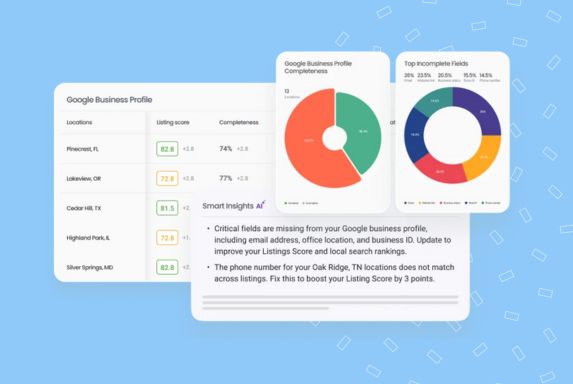
Your Google Business Profile is your restaurant’s digital storefront in local search results. Successful optimization requires complete and accurate information across all profile sections. Here’s how you can do it:
- Complete every profile section meticulously. Each section contributes to your business’s overall appeal. Start with basic details like your business name, address, and phone number, and then move on to the detailed sections.
- Upload professional, high-resolution images: Adding high-quality photos of your restaurant’s interior, exterior, and signature dishes makes it easier for diners to assess your restaurant.
- Include accurate business categories: Choose categories that suit your business, align with user intent, and help you compete with other local restaurants.
- Regularly update operating hours and contact information: Regular updates to operating hours, especially during holidays or special events, maintain profile accuracy.
- Add special attributes: Adding special attributes like wheelchair accessibility, outdoor seating, or delivery options helps potential customers make informed decisions.
2. List your restaurant on popular restaurant directories and marketplaces
Maintaining consistent listings across multiple online directories amplifies your online visibility and strengthens local SEO impact.
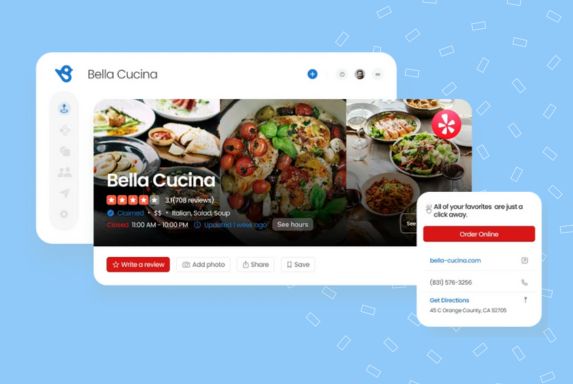
Begin with major platforms like Yelp or OpenTable, ensuring your restaurant’s information matches exactly across all listings. Each platform serves different audience segments – Yelp attracts local diners, TripAdvisor targets tourists, and OpenTable focuses on reservation-making customers.
Local directory listings also build valuable backlinks to your website. To maximize their impact, ensure your business information, menu links, and photos are consistently updated across all platforms. Regularly monitoring these listings helps maintain accuracy and allows quick correction of any inconsistencies that could harm your search rankings.
3. Identify the top keywords for your restaurant
Keyword research for restaurants requires a strategic focus on three main categories: cuisine type, ambiance, and services offered. Your local restaurant SEO keywords must adequately cover these criteria to rank higher on Google searches.
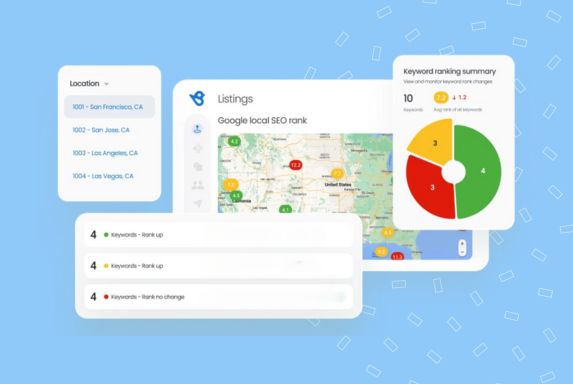
Start by identifying specific cuisine-related terms that potential customers use when searching, including both broad terms (“Italian restaurant”) and specific dishes (“authentic wood-fired pizza”).
Consider ambiance-related keywords that describe your restaurant’s atmosphere (“romantic dining,” “family-friendly restaurant,” “upscale steakhouse”).
Service-related keywords should highlight special offerings like “private dining rooms,” “catering services,” or “outdoor seating.”
Combine these with location-specific terms to create targeted relevant keyword phrases that match local search intent and drive relevant traffic to your website.
4. Build an engaging website
An engaging restaurant website combines visual appeal with practical functionality. Here are a few restaurant website SEO tips for your business:
- Focus on creating a clean, intuitive design that showcases your food and atmosphere through high-quality images.
- Include essential information like location, hours, and contact details prominently on the homepage.
- Feature your menu in an easily readable, text-based format that search engines can crawl.
- Integrate an online reservation system and make it visible across all pages. Include a blog section for sharing restaurant news, events, and culinary content.
- Ensure the website loads quickly and provides a seamless experience across all devices.
- Regular updates to content, especially menu items, and special promotions, keep the site fresh and relevant for search engines and website visitors.
Pro tip: Go a step further than just featuring the menu on your website. Write detailed descriptions highlighting signature dishes' origins, explaining unique preparation methods and key ingredients. Create compelling narratives around your menu categories, special offerings, and seasonal changes. This approach enhances SEO for the restaurant website through rich, relevant content and helps build an emotional connection with potential customers before they visit your restaurant.
5. Optimize for website for mobile visitors
Mobile optimization is crucial as most restaurant searches happen on mobile devices, especially smartphones. Ensure your website automatically adjusts to different screen sizes while maintaining functionality and readability. Mobile optimization on your restaurant works across the user interface (UI) and the backend processing. Make sure that your business:
- Makes buttons and links large enough for easy tapping on mobile screens.
- Optimizes images to load quickly on mobile networks while maintaining visual quality.
- Implements a mobile-first navigation structure that prioritizes essential information like menus, reservations, and contact details.
- Uses legible fonts and adequate spacing for a mobile-friendly experience.
- Test your mobile site’s loading speed regularly and optimize elements that slow it down.
Meet diners on the first page of Google
Want to see the impact of Birdeye on your business? Watch the Free Demo Now.
6. Focus on the technical side of your restaurant’s website
Technical SEO forms the foundation of your restaurant’s online visibility. While it may seem daunting to monitor the many moving parts involved, here is what you need to know:
- Implement proper schema markup to help search engines understand your business details, menu items, and pricing.
- Optimize page loading speeds through image compression, browser caching, and minimizing code.
- Create a logical site structure with clear navigation paths and breadcrumb trails. Ensure secure browsing with SSL certificates and HTTPS protocols.
- Make your site crawler-friendly by submitting sitemaps to search engines and using robots.txt effectively.
- Address technical issues like broken links, duplicate content, and 404 errors promptly. Regular technical audits help maintain optimal website performance and search engine visibility.
7. Create location-specific content for your website
Develop content that resonates with your local community and boosts your restaurant’s local search presence. For multi-location restaurants, striking a balance between a global presence and local connection is crucial.
Location-specific content can help you meet diners at different stages of their decision-making process and build a relationship even before they need a restaurant booking.
To maximize location-specific content for SEO, consider the following tips:
- Create neighborhood-specific landing pages highlighting your restaurant’s connection to the area.
- Share stories about local ingredients and suppliers you work with.
- Write blog posts about local food trends and seasonal specialties. Include area-specific keywords naturally in your content.
- Create guides to local attractions near your restaurant, making your restaurant’s site a valuable resource for both locals and tourists.
Pro Tip: Local content is not just for your diners - it also sends a strong signal to Google and other search engines that your restaurant website is the place that can address most topical local queries. Strong SEO-focused local content can also help you rank higher for non-branded searches, building industry authority.
8. Build a strong presence on social media
A strong social media presence across platforms where your target audience is most active can be immensely beneficial in building brand awareness. The more potential customers hear about your business, the more likely they are to click on your site/profile on Google. Higher clicks instantly translate into higher ranking on local searches.
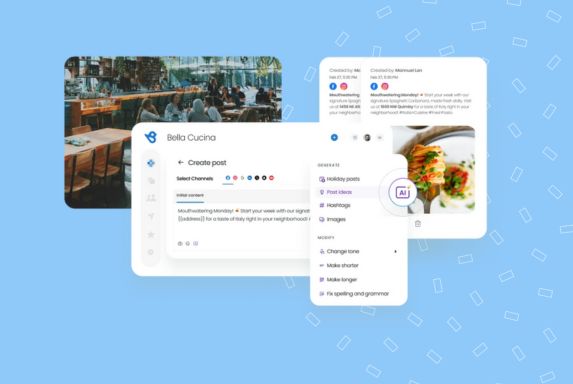
However, managing a multi-location social media presence can be difficult for restaurants. Here is how you can streamline your efforts and improve your ROI from social media activities:
- Focus primarily on visual platforms like Instagram and Facebook for showcasing food photography and behind-the-scenes content.
- Use local hashtags strategically to increase visibility in your area.
- Share user-generated content from satisfied customers to build social proof.
- Create engaging posts about daily specials, events, and promotions.
- Maintain consistent posting schedules and engage with followers regularly.
- Use platform-specific features like Instagram Stories or Facebook Events to maximize engagement.
- Monitor social media metrics to understand which content performs best with your audience.
Pro Tip: Daily content creation can be daunting, especially when personalizing it for multiple platforms and location-based accounts. Work with social media management tools like Birdeye Social AI that let you delegate a major chunk of work to GenAI-based tools for content creation, hashtag selection, image optimization, and personalization.
9. Generate and manage customer reviews effectively
Customer reviews play a crucial role in determining your ranking in local searches. Google favors businesses that customers are more likely to have a good experience with, using reviews as a signal to determine that. How well your business generates and manages restaurant reviews decides how high you rank on Google.
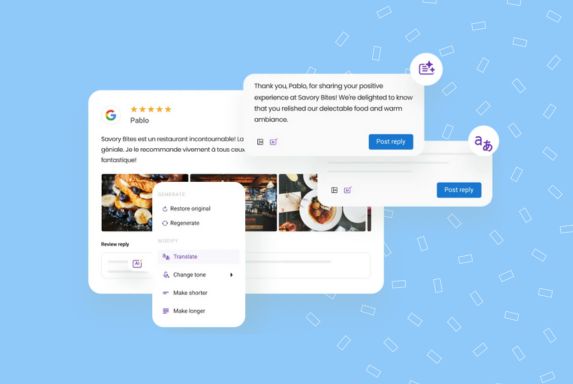
To effectively manage online reviews across multiple sites, a systematic approach to generating and responding to customer feedback is essential. Here is how your restaurant business can achieve that:
- Implement a consistent process for requesting reviews from satisfied customers, perhaps through follow-up emails or table cards with QR codes.
- Respond to all reviews promptly, whether positive or negative, maintaining a professional and constructive tone.
- Create standard response templates for common situations while personalizing each reply.
- Address negative feedback by acknowledging concerns and outlining specific solutions. Take conversations about serious issues offline while maintaining transparency about resolved problems.
- Use review insights to improve operations and demonstrate your commitment to customer satisfaction through visible changes based on feedback.
10. Improve the online ordering system
Enabling convenience ensures that your business continues to be the diners’ choice at all times. Online ordering is a major convenience that can help you boost your revenue even if the diner is not looking to book a table. This guarantees higher clicks and ultimately improves SEO performance.
You can streamline your online ordering system by:
- Ensuring your online menu is organized with accurate prices, descriptions, and high-quality images.
- Implementing an intuitive ordering interface that works smoothly across all devices.
- Including clear options for customization, special requests, and dietary preferences.
- Providing real-time updates about order status and estimated preparation times.
- Integrating multiple payment options and ensuring secure transaction processing.
- Making it easy to save favorite orders and delivery addresses for repeat customers.
- Including clear information about delivery areas, minimum orders, and additional fees.
11. Enable online table booking and confirmations
Convenience in the modern-day restaurant industry means ease of table booking and reservation confirmations. Businesses that offer these solutions quickly become the top choice for diners.
Enabling these solutions can be easier than you think with a few simple steps:
- Integrate your reservation system with your website, Google Business Profile, and popular booking platforms like OpenTable and Resy.
- Implement automatic confirmation and reminder systems through email and SMS with options for easy modification or cancellation of reservations online.
- Include special request options for celebrations or dietary requirements.
- Provide real-time availability updates and waitlist management.
- Consider implementing a loyalty program integrated with your reservation system.
- Use reservation data to optimize seating arrangements and staffing levels.
12. Use AI chatbots to improve diner experience
Every online interaction comes with a million questions, and while you can update your business listings/websites with all the information, nothing beats the ability to ask questions and get answers in real time. However, staffing customer support centers or receptions 24/7 is not an ideal solution for restaurants.
That is where solutions like Birdeye Chatbots AI can step in and save the day for your business and diners alike. With AI chatbots, your business can:
- Train the tool to handle frequent questions about hours, location, parking, and menu items to provide instant customer service and support for common inquiries.
- Enable basic reservation assistance and status checks for orders. Include personality elements that match your restaurant’s brand voice.
- Ensure seamless handoff to human staff for complex inquiries.
- Implement multiple language support if your customer base is diverse.
- Use chatbot interactions to collect customer data and preferences and monitor chatbot performance metrics to optimize response accuracy and customer satisfaction.
A quick SEO checklist for restaurants
Here is a quick SEO checklist for restaurant SEO services and owners to boost their presence:
Conduct a digital presence audit
- Review all online listings
- Verify NAP consistency
- Update outdated information
- Remove duplicate listings
- Monitor listings consistently
Strengthen the technical infrastructure
- Build a mobile-responsive website
- Check and implement fast-loading speeds
- Secure hosting
- Implement a SSL certificate
- Develop an XML sitemap
Focus on content optimization
- Build a location-based keyword roadmap
- Develop unique and engaging content with a focus on personalization
- Regularly update existing content
- Create unique and impactful multimedia (images/videos) for engagement
Work on review management
- Develop active review monitoring systems
- Work with AI and set up automation for prompt professional responses
- Encourage customer feedback
- Develop a reputation management protocol
Frequently asked questions on restaurant SEO
SEO typically 3-6 months for meaningful improvements. However, with consistent effort and strategic implementation, restaurants can quickly start seeing tangible results.
While ads provide immediate visibility, SEO offers long-term, cost-effective organic growth with higher trust and sustained restaurant traffic.
The exact SEO budget varies for each business, but small to medium restaurants should consider $500-$1500 monthly for professional SEO services.
While restaurants can handle basic optimization, professional services provide deeper expertise, saving time and delivering more comprehensive results.
Critical factors in restaurant SEO include Google My Business optimization, building a strong website, and maintaining consistent/accurate local business information across all online platforms.
Restaurant SEO – your path to digital dining dominance
Restaurant SEO is critical to building a stronger brand in a competitive industry. However, it is important to realize that it isn’t just a marketing tactic—it’s a method to build and fortify your digital storefront. By implementing proven and effective SEO strategies, restaurants can transform online searches into seated customers, boosting visibility and revenue.
Supercharge your restaurant’s SEO efforts with Birdeye’s GenAI tools
Dominating search engines for local restaurant searches is not just about making a few changes to your approach or Google Business Profile – it is a complex operation. The complexity only increases a thousand-fold for multi-location restaurants handling franchisees and other subsidiary locations.
In such cases, you need a trusted AI-charged partner like Birdeye to give you every possible advantage. With Birdeye, restaurants can:
- Build, scale, and manage multiple local listings on Google, Apple, Bing, and Facebook to boost visibility. You can write SEO-friendly business descriptions with Listings AI.
- Manage a multi-location social media presence with Birdeye Social AI to create content, optimize for engagement, and gain in-depth insights on customer behavior from social media interactions.
- Deploy AI chatbots to scale customer interactions, improve customer experience, and supercharge conversion with Chatbot AI.
- Manage online reputation with easy review generation, AI review responses, and in-depth insights with Reviews AI.
- Streamline digital reservations with Appointments, Payments, and other integrated solutions.
And so much more.
Birdeye is the AI solution to step up your game and outshine competitors. Want to learn more? Watch a free demo now.

Originally published




![[Feature image] Local SEO mistakes -what’s holding your business back from ranking locally](https://birdeye.com/blog/wp-content/uploads/Feature-image-Local-SEO-mistakes-whats-holding-your-business-back-from-ranking-locally-375x195.jpg)



